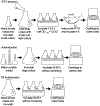Implementing a Hybrid Expression Method That Allows Upper-Division Biochemistry Lab Students To Engage in a Full Protein Production Experience While Allowing Ample Time for Characterization Experiments
- PMID: 34079146
- PMCID: PMC8168722
- DOI: 10.1021/acs.jchemed.8b00674
Implementing a Hybrid Expression Method That Allows Upper-Division Biochemistry Lab Students To Engage in a Full Protein Production Experience While Allowing Ample Time for Characterization Experiments
Abstract
Protein structure, function, and signaling are a large portion of biochemistry. Because of this, proteins are often used as model systems in biochemistry laboratory courses, where a course-long project might comprise protein expression, purification, and characterization. Two common protein expression methods are isopropyl β-d-1-thiogalactopyranoside (IPTG) induction, which utilizes easy-to-make media but requires extensive cell-growth monitoring that is time-intensive, and autoinduction, which employs multicomponent media that are time-consuming to make but require no cell-growth monitoring. A protein expression method that is a hybrid of IPTG induction and autoinduction is presented. The hybrid method utilizes the medium of IPTG induction and the no-cell-growth-monitoring induction process of autoinduction, saving hands-on time in the protein expression phase to allow more time for protein characterization while still having students execute each step.
Keywords: Biochemistry; Enzymes; Graduate Education/Research; Hands-On Learning/Manipulatives; Laboratory Instruction; Proteins/Peptides; Upper-Division Undergraduate.
Conflict of interest statement
The authors declare no competing financial interest.
Figures



Similar articles
-
Utilizing Mechanistic Cross-Linking Technology to Study Protein-Protein Interactions: An Experiment Designed for an Undergraduate Biochemistry Lab.J Chem Educ. 2017 Mar 14;94(3):375-379. doi: 10.1021/acs.jchemed.6b00453. Epub 2017 Feb 3. J Chem Educ. 2017. PMID: 29255327 Free PMC article.
-
From gene to structure: Lactobacillus bulgaricus D-lactate dehydrogenase from yogurt as an integrated curriculum model for undergraduate molecular biology and biochemistry laboratory courses.Biochem Mol Biol Educ. 2018 May;46(3):270-278. doi: 10.1002/bmb.21114. Epub 2018 Mar 7. Biochem Mol Biol Educ. 2018. PMID: 29512269
-
Biochemistry course-based undergraduate research experience: Purification, characterization, and identification of an unknown lactate dehydrogenase isoenzyme.Biochem Mol Biol Educ. 2020 Jul;48(4):369-380. doi: 10.1002/bmb.21363. Epub 2020 Jun 16. Biochem Mol Biol Educ. 2020. PMID: 32544299
-
Light-induced gene expression with photocaged IPTG for induction profiling in a high-throughput screening system.Microb Cell Fact. 2016 Apr 23;15:63. doi: 10.1186/s12934-016-0461-3. Microb Cell Fact. 2016. PMID: 27107964 Free PMC article.
-
Doing that thing that scientists do: A discovery-driven module on protein purification and characterization for the undergraduate biochemistry laboratory classroom.Biochem Mol Biol Educ. 2015 May-Jun;43(3):145-53. doi: 10.1002/bmb.20844. Epub 2015 Mar 4. Biochem Mol Biol Educ. 2015. PMID: 25735767
References
-
- Arkus KAJ; Jez JM An integrated protein chemistry laboratory. Biochem. Mol. Biol. Educ 2008, 36 (2), 125–128. - PubMed
-
- Stahelin RV; Forslund RE; Wink DJ; Cho W Development of a biochemistry laboratory course with a project-oriented goal. Biochem. Mol. Biol. Educ 2003, 31 (2), 106–112.
-
- Vincent JB; Woski SA Cytochrome c: A Biochemistry Laboratory Course. J. Chem. Educ 2005, 82 (8), 1211–1214.
-
- MacDonald G Teaching Protein Purification and Characterization Techniques. A Student-Initiated, Project-Oriented Biochemistry Laboratory Course. J. Chem. Educ 2008, 85 (9), 1250–1252.
-
- Miller S; Indivero V; Burkhard C Expression and Purification of Sperm Whale Myoglobin. J. Chem. Educ 2010, 87 (3), 303–305.
Grants and funding
LinkOut - more resources
Full Text Sources
Miscellaneous
